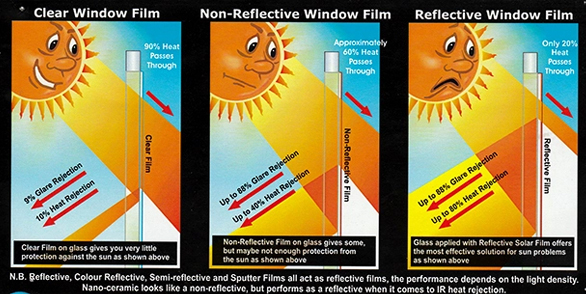Effect of Daylight In Buildings
Daylight effect in Buildings
Light is an important factor when designing a building for ambiance and health reasons. The size of a window opening as well as the location will make a huge difference to the comfort of the occupants and is important to the wellbeing of humans in their living and working environments.
The quality and quantity of daylight changes with locations - time of the day, time of the year and weather conditions. These changes affect the appearance of the interior of a building. The problem with large windows is that they contribute to an overload of heat and glare pouring through the glass creating hot spots This is the area where sun control window film plays its important role as it stops the suns heat but still allows the daylight in.
The source of sunlight varies and to have ample reliable daylight one needs a good distribution of illumination from the sun through the clouds, the intensity as measured in different parts of the world.
Also the winter sun is lower and more intense than the summer sun. Sun problems in summer are different to sun problems in winter even on windows in the same building. Winter glare is a huge problem as the sun is lower and more intense.

The luminance distribution of an overcast sky and a clear sky varies, e.g. location, latitude and time of day.
Daylight predictions for interior spaces is usually based on a daylight factor concept. The daylight factor is a ratio used in percentages of light measured directly or indirectly from sun light. External reflections are also received from the ground, sea and buildings or exterior factors. Internal reflectivity can also play a part with reflections of objects once the sun’s rays pass through the glass.
The effect of daylight and artificial light plays an important part in the efficiency of any building. Building occupants traditionally require daylight to work by, to enhance the visual quality of the interior and to save on increasing electric lighting bills.
Versus codes of practice are required in industry to ensure workers have ample light without the direct sunlight. Sometimes the use of glass in an attempt to admit more sunlight may rise to solar overheating. This is the time when Klingshield sun control window film
plays its part to solve these problems.
The effective use of daylight through good window design can reduce artificial lighting of the largest single saving of energy. Clear glass has a light transmission of 90% and under normal daylight conditions can reach a depth of about 6 meters. Reducing the height of a window reduces the depth of daylight penetration. Roof lights give good daylight distribution. However most humans can't live under clear glass roofs. The heat build-up is usually unbearable. Sun
control window film is very popular for sky lights and sunrooms.
Offices workers have problems when sitting next to a window as the bright daylight causes discomfort and thousand of installations of sun control film have been installed to rectify these problems.
Jingle Song "Blurred Eyes".
